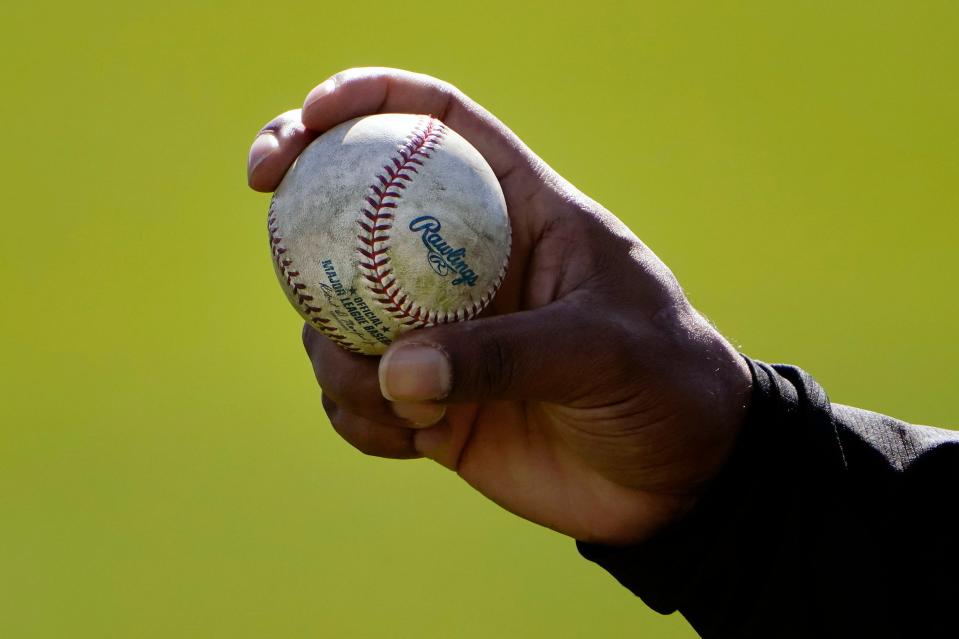Unlike past MLB scandals, players face instant scrutiny in crackdown on foreign substances
Shane Bieber, the reigning American League Cy Young Award winner, was struggling. The light-hitting Seattle Mariners raked him for 10 hits and five earned runs in his start Sunday and became the first team to hit two home runs off his curveball in one game.
It was time to jump to conclusions.
Myriad journalists and online observers scurried to his StatCast data, which revealed the spin rate on his curveball was down 303 rpms, or 14%. The mystery was solved, or at least the implication clear: Bieber was surely among a group of pitchers who halted aggressive use of banned, foreign substances in advance of a Major League Baseball crackdown.
A day later, Bieber was placed on the injured list with a shoulder strain.

He won’t throw a baseball for two weeks, a pivotal blow to a Cleveland team hoping to stay close to the Chicago White Sox in the AL Central. There was a broader lesson in this saga for fans and media ready to pounce on what may be baseball’s most widespread scandal in a decade:
A drop in performance – or spin rate – does not necessarily correlate to a pitcher suddenly ceasing the use of foreign substances on the baseball.
“It’s 162 games in 180 days. There’s going to be injuries, little things you have to play through,” says Miami Marlins reliever Ross Detwiler, who’s in his 13th season and says MLB’s foreign-substance crackdown “is not going to affect me at all.
“I don’t think it’s, ‘OK, this guy’s spin rate’s down, his slider’s not as good, his fastball’s not jumping as much, so it must be sticky. The way things are these days, people will jump to conclusions. But it’s not always the right one.”
MLB’s Tuesday announcement that beginning June 21 it will instruct umpires to vigorously enforce rules against foreign-substance use comes after years of players pushing the rulebook too far, leaping from the gentlemanly and accepted use of pine tar to more complex and impactful products like Spider Tack, stuff that crosses the line from control aid to performance-enhancer.
And so, not unlike the great awakening on steroid use at the turn of this century, the hunt is on.
Who’s been gooping up? And who’s going to get shelled when they stop?
This will be an inquisition unlike any we’ve seen.
When batters and pitchers alike juiced up with steroids, growth hormones and other PEDs for much of the 1990s and 2000s, the lone evidence was in physical changes to a player or a spike in their slugging percentage or strikeout rates. In the absence of drug testing, which did not begin until 2003, some players were so blatant in their usage that fans could reasonably intuit something was amiss based on performance.
Meanwhile, dozens of others skated past the suspicion and even received a lifetime immunity of sorts if they were not entangled in the Mitchell Report, MLB’s 2007 investigation into PED use that implicated nearly 100 players yet was far from an exhaustive accounting of PED use.
Now, in the great sticky crackdown of 2021?

Observers need only point their browsers to a player’s statistical performance and his spin rate data, easily accessible on Baseball Savant, an advanced-metrics web site now under MLB’s umbrella.
Was Bieber’s poor performance injury-related or because he swore off foreign substances? Is a 12% drop in spin on his curveball from an early April start to a June 3 start – two days after MLB informed owners a crackdown was coming – due to substance cessation or any of the dozens of factors, including health, that affect pitching performance?
With umpires authorized to shake down pitchers multiple times per game, those caught red-handed – or on their belt, glove, cap, shoes, whatever – will be nailed in plain sight and suspended.
Those who suddenly regress, with either their spin rate plummeting or their ERA soaring, may find themselves indicted in the court of public opinion without physical evidence.
“In the steroid era, if someone was good, it was automatically, ‘He’s on steroids,’” Red Sox reliever Matt Barnes said after Boston’s previously solid pitching staff was pounded for 53 runs over six games last week. “The easiest way to justify someone being bad or good over a stretch is something other than what it really is. It’s just the easiest way to talk about it. That’s what happens when you play 162 games. There’s too many games to stay at an elite level for every single one of them.
“(Foreign substances) just seems like an easy way out.”
Indeed, a Boston Globe analysis of Red Sox pitchers revealed no substantial drop in pitcher spin rate during their staff-wide slump, which also came in the days following the news of the impending crackdown.
The cat-and-mouse game between players and the game’s enforcement wing will now be enhanced – the cat, in this case, umpires, will be ordered to check pitchers multiple times a game. Balls and, if necessary, equipment, will be collected as evidence. Yet rooting out all foreign substance use is virtually impossible – particularly if pitchers inspected and found to be clean are emboldened.
“You’re not supposed to break the speed limit, too. But you do. You know what I’m saying?” says Astros manager Dusty Baker.
Meanwhile, much of the rhetoric from the steroids era has returned, with players and executives either claiming/feigning ignorance or welcoming scrutiny, taking Detwiler’s tack that they have nothing to hide. New York Yankees GM Brian Cashman said Tuesday that he’d “never heard of Spider Tack until three weeks ago. Honest to God.”
That would put him at odds with the dozens of players who have either used it or experimented with it or chatted about it in long walks to the outfield to shag fly balls or the many hours of dead time spent with comrades in the bullpen.
Many will be fighting a public perception battle wrought by one of their peers. Dodgers starter Trevor Bauer claimed in 2020 that upward of 70% of pitchers use foreign substances. In 2018, he essentially confirmed he experimented with a pine tar mixture during the first inning of one start, if only to illustrate how that one-inning spike in spin rate proved the efficacy of foreign substances.
And after perhaps joining them instead of trying to beat them, his spin rates soared as he won the 2020 NL Cy Young Award, and then dipped in recent weeks.
Perhaps he laid off the stuff. Perhaps he’ll turn back into a league average-ish pitcher post-crackdown, albeit after securing $102 million over three years from the Dodgers.
And perhaps only the tincture of time can tell us the whole story – eager though we might be to scamper online, calculate a dip in spin rate and convict the guilty party.
“I think false correlations are made every single day,” says Brewers manager Craig Counsell. “Every player in there deals with a false correlation nearly every day he plays the game. It’s part of being a professional athlete, especially the world these athletes live in with social media.
“I don’t think it’ll be that obvious. I think there’s going to be adjustment periods and then it will all go back to normal. Good players are going to be good players.”
This article originally appeared on USA TODAY: MLB foreign substance crackdown may end up causing hysteria

